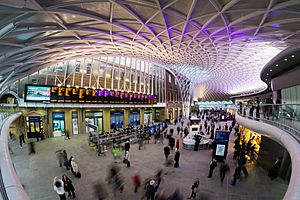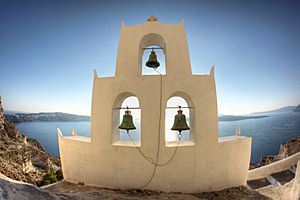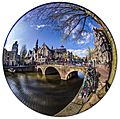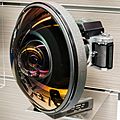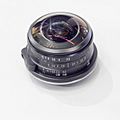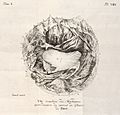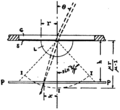Fisheye lens facts for kids
A fisheye lens is a special type of wide-angle lens used in cameras. It gets its name because it makes pictures look like what a fish might see from underwater. These lenses capture a very wide view, much wider than a normal camera lens.
Unlike regular wide-angle lenses, fisheye lenses make straight lines in a photo look curved, especially if they are not in the very center of the picture. This creates a unique, distorted effect.
Fisheye lenses can see a huge area, usually between 180 and 220 degrees. Some special ones can even see up to 270 or 310 degrees! Even though they show such a wide view, fisheye lenses often have less vignetting. Vignetting is when the edges of a photo look darker than the middle.
Because they can see so much at once, fisheye lenses are often used in security cameras for surveillance. This helps them cover a large area without needing many cameras.
Contents
How Fisheye Lenses Work
Fisheye lenses use a special way of showing the world called gnomonic projection. This is different from how normal lenses work. It's this projection that causes the unique curved look of straight lines.
Types of Fisheye Lenses
There are two main types of fisheye lenses:
- Circular fisheye lenses: These lenses create a circular image in the middle of the camera's sensor. The rest of the image area around the circle is black.
- Full-frame fisheye lenses: These lenses fill the entire rectangular frame of the camera's sensor. They still show the curved distortion, but the image covers the whole picture.
Why Pictures Look Curved
When you look at a picture taken with a fisheye lens, straight lines that are not in the very center of the image will appear bent or curved. This happens because the lens is trying to fit a super-wide view into a flat picture. Imagine trying to flatten a globe onto a piece of paper; some parts would have to stretch or bend. Fisheye lenses do something similar with light.
Uses of Fisheye Lenses
Fisheye lenses are used for many different things, not just surveillance.
- Photography: Photographers use them to create artistic and dramatic effects, especially for landscapes, architecture, or action sports. They can make buildings look huge or capture an entire scene in one shot.
- Virtual Reality (VR): These lenses are great for capturing 360-degree views that can be stitched together to create virtual reality experiences.
- Science: Scientists use them for things like studying the sky (all-sky cameras) or observing plant canopies.
Images for kids
-
The curves of ESO's headquarters through a fish-eye lens.
-
"Vue circulaire des montagnes qu'on découvre du sommet du Glacier de Buet", Horace-Benedict de Saussure
See also
 In Spanish: Objetivo ojo de pez para niños
In Spanish: Objetivo ojo de pez para niños


